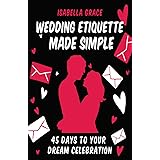Navigating new cultures can sometimes feel like solving a complex puzzle, especially when it comes to significant events like weddings. For English language learners, understanding the customs and specific vocabulary of American weddings can present a unique challenge. Thankfully, English teacher Amy Joy offers a fantastic guide in the video above, demystifying these beautiful celebrations for everyone.
This article builds upon Amy Joy’s excellent video, providing a deeper dive into the fascinating world of American wedding traditions. We will explore common practices, expand on key vocabulary, and offer additional insights to help you fully grasp what to expect. Get ready to enhance your English vocabulary and gain a comprehensive understanding of American wedding culture.
Understanding American Wedding Customs: A Deeper Look
American weddings are rich with traditions, blending sentimentality with joyous celebration. From the moment guests arrive until the last dance, each element holds significance for the couple and their loved ones. Let’s explore these customs, expanding on the insights shared by Amy Joy in her video.
1. Thoughtful Gift-Giving and the Registry System
One of the first traditions guests encounter at American weddings is the practice of giving gifts to the couple. Amy Joy mentioned the gift registry, which is a highly practical system designed to help newlyweds start their shared life. This registry is a curated list of desired items, often kitchenware, home decor, or other household essentials, pre-selected by the couple.
Couples typically register at one or more retail stores or online platforms, making it convenient for guests to choose a gift that is truly needed. Asking “Where are you registered?” or requesting a “registry link” is completely acceptable and ensures your gift is both appreciated and useful. While physical gifts are common, many couples also appreciate monetary gifts, especially if they are saving for a honeymoon or a down payment on a new home.
2. The Wedding Ceremony: A Journey Down the Aisle
The heart of any wedding is the ceremony, where the couple officially becomes married. American ceremonies often combine formal moments with personal touches, making each event unique. As Amy Joy highlighted, seating arrangements can vary; while traditionally guests of the bride sit on one side and guests of the groom on the other, many modern weddings embrace the “pick a seat, not a side” approach, fostering a unified atmosphere.
The “aisle” is a crucial part of the ceremony space, serving as the pathway the wedding party and the bride walk down to reach the “altar.” This term isn’t always a religious structure; it simply marks the central spot where the couple stands during the ceremony. When the bride makes her grand entrance, guests typically rise as a sign of respect and anticipation, creating a truly memorable moment for everyone present.
Understanding Wedding Vows and Commitments
At the altar, the bride and groom exchange “vows,” which are heartfelt promises they make to each other. These vows can be traditional, using standard phrases of love, fidelity, and support, or they can be deeply personal, written by the couple themselves. The exchange of vows is often the most emotional part of the ceremony, symbolizing the couple’s lifelong commitment. Amy Joy also introduced the expression “to be left at the altar,” which is a dramatic idiom referring to a last-minute cancellation of the wedding by one partner, thankfully a rare occurrence in real life.
3. The Essential Roles of the Wedding Party
The “wedding party” comprises close friends and family members who provide support to the bride and groom throughout the wedding journey. These individuals often stand alongside the couple during the ceremony, playing significant roles in the celebration. Their presence highlights the strong bonds of friendship and family surrounding the newlyweds.
The “groomsmen” are friends or male relatives of the groom, while the “bridesmaids” are friends or female relatives of the bride. Each group offers practical assistance and emotional support. The “best man,” usually the groom’s closest friend or brother, often holds the rings and delivers a toast at the reception. Similarly, the “maid of honor,” typically the bride’s closest friend or sister, assists the bride with her dress, holds her bouquet, and also gives a toast. Modern weddings frequently see a blending of these roles, with “groomswomen” or “men of honor” becoming more common, reflecting the diverse relationships in people’s lives.
4. Reception Festivities: Celebrating the Happy Couple
Following the ceremony, the “reception” is a vibrant party where guests gather to celebrate the newly married couple. This celebratory event typically includes dinner, dancing, and various other activities. Amy Joy highlighted several key traditions that make American wedding receptions so special and engaging.
Guests often find their seats using a “seating chart,” which helps organize the dining experience and encourages mingling among different groups. Before or during the reception, a “guestbook” or an “advice station” allows guests to write well wishes or offer marriage advice to the couple. These messages become cherished keepsakes for the newlyweds, documenting the love and support they received on their special day.
Grand Entrances and Memorable Dances
A highlight of the reception is the “grand entrance,” where the entire wedding party, followed by the bride and groom, makes a festive entrance into the reception venue. This moment is usually accompanied by enthusiastic applause and upbeat music, setting an energetic tone for the evening. Following this, the “first dance” is a cherished tradition where the husband and wife share their inaugural dance as a married couple, often to a song meaningful to them.
Other traditional dances include the “father-daughter dance,” a touching moment between the bride and her father, and sometimes a “mother-son dance” between the groom and his mother. These dances are highly emotional and create lasting memories. Music is a central part of American wedding receptions, with live bands or DJs often playing a mix of popular songs for guests to enjoy. The “Cupid Shuffle,” as mentioned by Amy Joy, is a popular line dance that many guests know and love, often seen at weddings for its inclusive and fun nature. The video also showcased a “chair dance,” a lively Jewish wedding tradition, demonstrating the beautiful cultural diversity sometimes found within American celebrations.
Wedding Favors and Culinary Delights
As a gesture of gratitude, many couples provide “wedding favors” to their guests. These small gifts, such as the hand sanitizer and candles Amy Joy received, serve as a thank-you for attending the celebration. Favors can range from edible treats like chocolates or cookies to small, personalized items that reflect the couple’s interests.
Dinner is a major component of the reception, with couples offering various culinary options to their guests. Amy Joy mentioned filet mignon and fish as examples, showcasing the diverse meal choices available. The “cake cutting” ceremony is another sweet tradition where the bride and groom jointly slice the first piece of their wedding cake. This symbolic act represents their first shared task as a married couple, often followed by playfully feeding each other a bite. Beyond the dinner and cake, many receptions feature additional entertainment, such as photo booths for fun pictures, beautiful fountains for ambiance, and an open bar offering a selection of drinks for guests to enjoy throughout the evening.
The Festive Bouquet Toss
The “bouquet toss” is a spirited tradition where the bride throws her wedding bouquet over her shoulder to a group of single women. According to tradition, whoever catches the bouquet is said to be the next person to get married. This playful event adds an element of excitement and anticipation, bringing laughter and cheers to the reception dance floor.
American weddings are vibrant celebrations, rich with traditions that honor love, family, and friendship. From the heartfelt vows exchanged at the altar to the lively dances at the reception, each custom contributes to a memorable experience for the couple and their guests. Understanding these American wedding traditions helps English learners grasp both the language and the cultural nuances of these joyous occasions.











